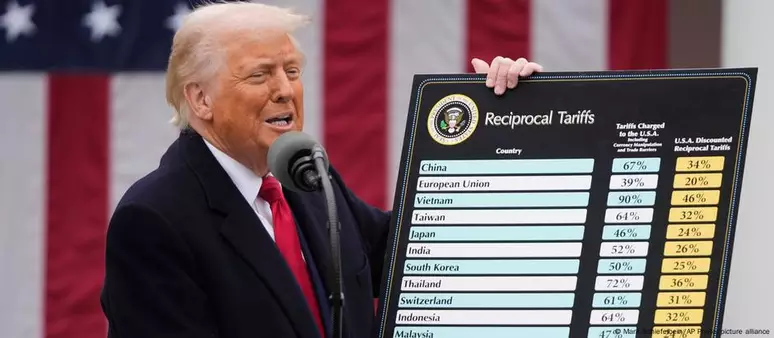
The 10% global tariffs announced this week by US President Donald Trump came into effect on Saturday, 5, making official a measure that threatens to further disrupt international markets.
Last Wednesday, the 2nd, a day he called “Liberation Day”, Trump announced a minimum tariff of 10% on 184 countries and territories, in addition to the European Union (EU), and in some cases increased the rates.
This additional tariff escalation, applied only to some of Washington’s trading partners, will come into effect next Wednesday.
What goes into effect now is a global 10% tariff that affects all products the United States imports from other nations.
However, goods already loaded onto a ship and in transit to the United States before 12:01 a.m. Saturday are exempt from the 10% tariff, according to the executive order signed by Trump on Wednesday. Those goods must arrive in the U.S. by May 27 to avoid customs duties.
This exception prevents goods already en route to the United States from being affected by the customs change.
The customs tariff is in addition to existing taxes, but some products are exempt, such as oil, gas, copper, gold, silver, platinum, palladium, lumber, semiconductors, pharmaceuticals and minerals not found on American soil.
Imports of steel, aluminum and automobiles are also not affected, but because they are already subject to 25% surcharges.
Canada and Mexico, US partners in the North American Free Trade Agreement (NAFTA), are under a different regime: 25% on products outside the agreement (except 10% on Canadian hydrocarbons).
Additional climbing
Next Wednesday (04/09), the trade war declared by the Republican will intensify, when higher taxes will come into effect for other countries, including those that export more than they import.
There will be +54% in total for China (adding several tariffs), +20% for the European Union (EU), +46% for Vietnam, +24% for Japan, +15% for Venezuela, +18% for Nicaragua.
The Falkland Islands will have a tariff of 41%. Argentina and the United Kingdom claim sovereignty over this archipelago, called the Falkland Islands by the British.
Trump’s list affects about 180 countries and territories, including the 27 countries of the European bloc, according to an official document published on Friday by the US government.
The number of countries most severely punished has been reduced: it no longer includes the French islands of St Pierre and Miquelon (in the Atlantic) or the Australian territories of the Heard and McDonald Islands, in the sub-Antarctic region, inhabited only by penguin colonies.
Their presence caused a stir and gave rise to all kinds of memes about these animals on social media.
Chinese reaction
China already responded on Friday by announcing additional tariffs of 34% on US products starting April 10.
Beijing also announced controls on exports of rare earths, including gadolinium, used in magnetic resonance imaging, and yttrium, used in electronics.
“China made a mistake, they panicked. The one thing they cannot afford to do,” Trump wrote in capital letters on his Truth social media account.
The US government has warned its trading partners not to retaliate against its tariffs as they risk additional surcharges on their exports to the United States.
Threat to the foundations of free trade
Trump’s tariffs threaten the foundations of free trade that have defined the world for decades and have already triggered a trade war with Washington’s traditional allies, such as Canada, and adversaries such as China, which has announced its own tariffs.
The taxes have also fueled fears of an economic slowdown, with the largest US bank, JPMorgan Chase, raising the chances of a global recession from 40% to 60%.
In the US, Federal Reserve Chairman Jerome Powell warned on Friday that Trump’s tariffs could lead to higher inflation and lower economic growth, noting that higher inflation could be persistent rather than temporary.
The tariffs also threaten to raise the price of goods such as housing, cars and clothing in the United States, particularly hurting the country’s poorest families, who could suffer a capital loss of up to 5.5%, according to a study by a Yale University research center.
“National emergency”
Trump imposed the tariffs using the additional authority he has as president to declare a “national emergency,” arguing that the current trade situation poses a security risk to the United States.
The president has promised that the tariffs will bring back to the United States jobs that have been moved to cheaper countries in recent decades. But in recent weeks he has also acknowledged that there could be a painful “transition” period for American families.
The last time U.S. tariffs were this high was after President Herbert Hoover (1929-1933) signed the controversial Smoot-Hawley Tariff Act in 1930, which raised duties on many imported goods to nearly 40%.
This measure is believed to have worsened the Great Depression, also known as the Crash of 1929, which lasted until the years leading up to World War II.



